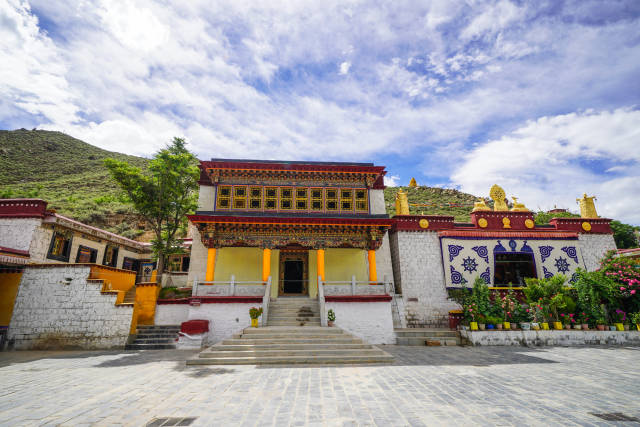Dadong Village, known as the most beautiful Tibetan village in China, is part of the government’s comprehensive poverty alleviation project. It aims to relocate low-income villagers from the “poor landscape pattern” into a new, well-planned and organized village.
To boost income, unite scattered villagers to establish uniform factories and increase traditional handicraft production while maintaining income from fields and pastures.
Previously, villages lacked resources to improve homes and attract tourists. Now, with government funds, new villages are built with folk design and better facilities. This makes them popular tourist spots, increasing villagers’ income.
Tourist Attractions in Dadong Village
This village in Liuwu New District, Lhasa City, Tibet, is 18 kilometres from Lhasa. It has easy transportation, stunning scenery, and many tourist attractions. Visitors can explore the ruins of the manor where the sixth Dalai Lama, Tsangyang Gyatso, lived and visit famous Tibetan medicine temples like Nimatang Temple and White Temple. The Dadong mountains and rivers offer abundant resources, including hidden horse chickens.
The ancient Dadong Village has developed as a “suburban weekend leisure tourism” destination, benefiting from its distinct natural resources and strategic location, resulting in a remarkable transformation.
The local building has a Tibetan style with red eaves, Tibetan patterns, and curtains. It creates a stunning contrast against the sky and clouds, resembling a beautiful landscape painting. It offers a peaceful, comfortable lifestyle away from the city.
In Tibet, experience breathtaking scenery, local customs, butter tea, cow dung fuel, and the villagers’ love for nature’s beauty.
This place invokes Haizi’s timeless poem, where I possess a seaside house, basking in the warm spring and blooming flowers. Starting tomorrow, I shall embrace happiness, tending to horses, chopping wood, and exploring the globe.
Nyima Tang Temple
Nimatang Temple in Dadong Village is an ancient temple with deep roots in Tibetan medicine. It showcases a picturesque landscape and preserves the unwavering faith of the Tibetan people. Among the notable ancient temples in this area, Nimatang Temple and White Temple stand out as they have stood for almost a millennium.
Nimatang Temple, a Tibetan Buddhist temple, is the birthplace of Tibetan medicine. It is believed to hold three treasures: Tibetan horse chicken, pharmacist Buddha, and Tibetan medicine classics.
Tibetan horse chicken is a renowned Tibetan medicinal herb with nourishing properties and serves as a medicinal source. Nimatang Temple houses a wealth of Tibetan medical classics dedicated to the revered Medicine Buddha.
Medicine Buddha temple
Upon entering the temple, the highlight is the magnificent Medicine Buddha temple, greatly admired by the locals. After exploring the hall, one can ascend the mountain using the stone steps located on the left side of the entrance. Alongside these steps, there is a series of prayer and wish meridians. Turning around, one can experience a sense of rejuvenation and well-being.
It is said that Nimatang Temple was built around the 12th century A.D. and was presided over by the famous translator at that time, Ra Lotsawa Dorje Chodak, It is said that when Ra Lotsawa first arrived here, he was deeply attracted by the pleasant scenery here, so he vowed to build a magnificent temple here like the sun.
After completing the Nimatang Temple, a famous doctor heard of Ra Lotsawa’s incredible power. Curious, he visited and saw Ra Lotsawa move the sun from the sky to the temple and back. Amazed, the doctor stayed to make Tibetan medicine and help the community. Tibetan medicine doctors came to promote its development.
White Temple
The renowned White Temple, constructed in the 12th century by Genna Doji, a skilled master of the Kadang School, showcases exquisite scenery and vibrant life. This temple is devoted to an assortment of valuable Buddha statues and a collection of meticulously handcrafted Kagyur, made of gold.
On the hillside of Qiangba Udui, opposite the White Temple, there is a naturally formed Maitreya Buddha statue. Besides, a white snail pattern naturally forms on the stone under the throne. In Tibet, the white conch holds immense significance in Tibetan Buddhism, particularly the right-handed white conch. It is highly revered and symbolizes the three thousand worlds and the reverberation of Dharma.
The temple in the green mountains offers stunning views with its white walls, red eaves, and towering ancient trees, all against the backdrop of a blue sky and white clouds. The surrounding landscape resembles colourful peacocks. Villagers in the vicinity visit the temple daily for worship, creating a vibrant atmosphere.

Dadong Village
Dadong Village is renowned as China’s most beautiful Tibetan village, boasting a serene environment. The hotel’s architecture exudes a distinctive Tibetan style, while the furnishings and bathrooms offer modern amenities, perfectly catering to tourists seeking an authentic cultural experience blended with convenience.
In the spring, it is even more pleasant. Have you ever seen rape flowers in the field? Do you enjoy the faint fragrance that fills the sky? Perhaps it didn’t catch your attention, as they are just ordinary flowers. But when they cluster together, it becomes truly spectacular! I must also mention the refreshing coolness of mushrooms in Lhasa, which is a beautiful sight. The stunning scenery and a warm smile melt your heart!


